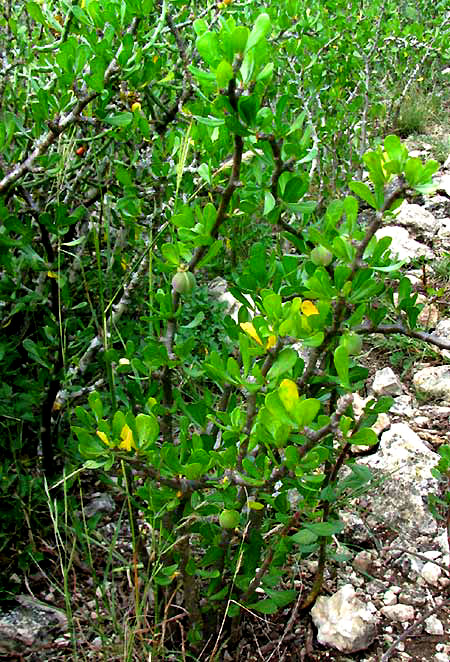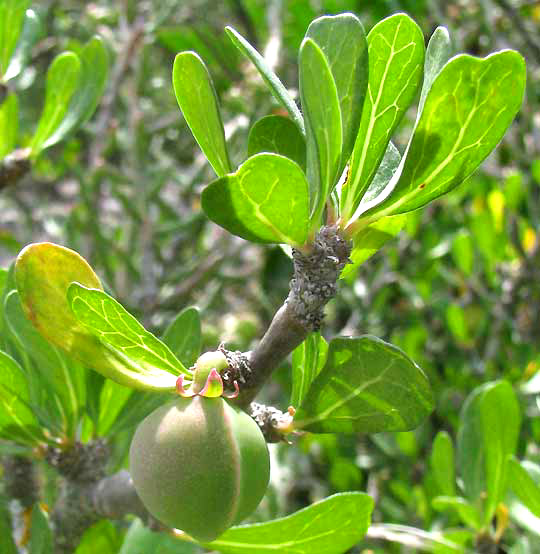Excerpts from Jim Conrad's
Naturalist Newsletter
from the October 6, 2013 Newsletter issued from the Frio Canyon Nature Education Center in the valley of the Dry Frio River in northern Uvalde County, southwestern Texas, on the southern border of the Edwards Plateau; elevation ~1750m (~5750 ft); N29.62°, W99.86°; USA
LEATHERSTEM
Farther west in and around the vast Chihuahuan Desert, one of the most abundant and easy-to-identify shrubs is the thicket-forming, knee-high bush shown below:

Notice that the plant's stems are unusually thick and rubbery-looking, and that the leaves arise not from slender side-branches but from knobby branch tips and stump-like modified stems along the main stems. A close-up showing an immature fruit below a tuft of branch-tip leaves appears below:

This is Leatherstem, also known as Sangre de Drago, Sangregrado and a host of other names. It's JATROPHA DIOICA, "dioica" in the binomial referring to the fact that the plants bear either male or female flowers, but not both on the same plant, so the plants are "dioecious."
Sometimes in rocky spots in the Chihuahuan Desert you find extensive thickets of Leatherstem, the stems issuing from subterranean rhizomes. Most hills in this area lack Leatherstem, but a few miles south of here on certain hilltops they're abundant.
Though I've known Leatherstem for decades, I almost didn't recognize these plants because they bear so many leaves. Throughout most of the year when it's either dry or cold, only leafless, spongy-looking, dark gray stems poke from the ground, causing some folks to call them Witch's Fingers. Our Leatherstems currently bear leaves because about a week ago we had a nice rain.
The Spanish name Sangre de Drago means "Dragon's Blood," referring to copious juice in the stems that changes from clear yellow to blood red when exposed to air.
With such unusual sap, and taking in mind that the plant belongs to the Poinsettia or Euphorbia Family, the Euphorbiaceae, harboring many species producing colorful and often toxic sap, you might expect that Leatherstem's sap also is worthy of consideration.
In fact, Leatherstem roots contain the compound riolozatrione (C20H26O3), which is a diterpene with antimicrobial properties. Sheep and goats who eat the plant experience severe gastroenteritis, vomiting, and abdominal pain. This doesn't deter Home-remedies-site.Com from claiming that Leatherstem is "Useful for controlling diarrhea, heal wounds, relieve hemorrhoids, and combat hair loss." The online Atlas de las Plantas de la Medicina Tradicional Mexicana agrees, saying that in Mexico Leatherstem has been used to keep hair from falling out, to wash bumps and bruises, cure mange, and for better anchoring one's teeth. Also, juice from squeezed fruit is dropped into the eyes of those with various eye problems. That latter cure is one I wouldn't try, since the sap of some members of this family is known to do permanent damage to eyes.
Leatherstem is mostly a Mexican plant found in the uplands of most of central and northern Mexico, but enters the US here in southwestern Texas. It's often conspicuous in Big Bend National Park to our west.
Because Leatherstem survives long periods without rain, and even in its leafless state looks interesting and unusual, it's a prime candidate for xeriscaping.